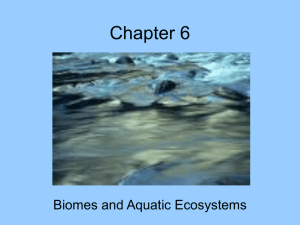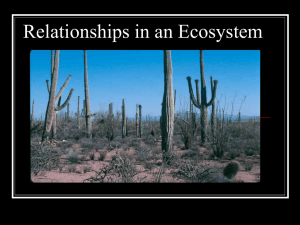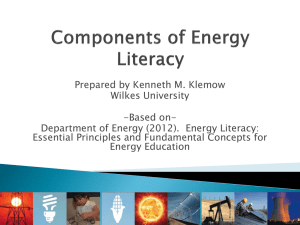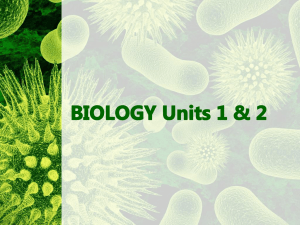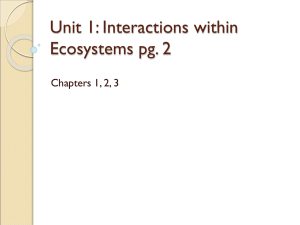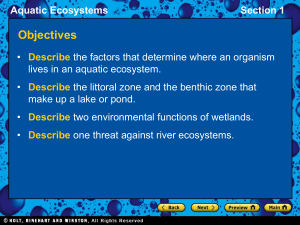Chapter 4 notes
advertisement
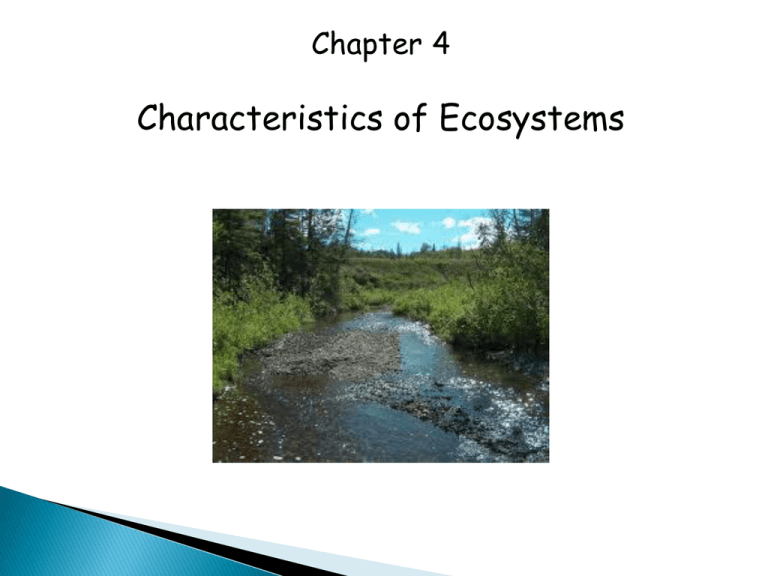
Chapter 4 Characteristics of Ecosystems 4.1 Interactions within ecosystems Define the following terms: Ecology: The study of interactions between organisms and their living and non-living environment. Abiotic factor: A non-living factor that influences an organism Biotic factor: A living factor that influences an organism Ecotones are the transition areas between ecosystems where organisms from both ecosystems interact with each other. Would you expect the biodiversity to be higher or lower in an ecotone? Roles in Ecosystems: Ecological niche describes an organisms place in the food web, its habitat, breeding area and time of day that it is most active (diurnal = active during the day; nocturnal = active at night) Although they occupy a very similar niche, competition between hawks and owls is reduced because of the time of day they feed. In general, the higher the number of niches in an ecosystem, the higher the biodiversity. Exotic species are species that have been introduced to an ecosystem. Can you think of any potential issues that may arise as a result of a new species entering an ecosystem? 4.2 Terrestrial and Aquatic Ecosystems Define biome. A large geographical region with a specific climate, and the plants and animals that are adapted to that climate. Terrestrial Ecosystems are found anywhere on Earth that is not covered by water. Most of Alberta’s terrestrial ecosystems are found within two major biomes. Which two do you think are found in Alberta? Taiga and grassland The Taiga: Also called the boreal forest, the taiga can be found throughout northern Alberta and along the Rocky Mountains. What type of trees dominate the taiga? Conifers What characteristics of conifers makes them well adapted to the taiga biome? The parts of the trees that reach up into the forest make up the canopy. How does the canopy differ between a deciduous forest and a coniferous forest? How do these differences determine what plants (and animals) will be found in the understory? Muskeg Ecosystems: Climate refers to the average conditions of temperature and precipitation of a region. What happens to the climate as we move further North in Alberta, and into the Northwest Territories? In the most Northern regions, it is sufficiently cold enough that there is a layer of permafrost beneath the soil that never melts. Rain and melted snow cannot drain in this part of the taiga, and the water soaks the decomposing plants and peat moss. This forms muskeg, ground that is swampy or boggy in the summer. Would you expect the organisms to be the same as those found in the conifer ecosystems? Decomposition is very slow in the muskeg ecosystem. How do you think this effects the quality of the soil in this ecosystem? Why? Would you expect the biodiversity to be high or low in the muskeg ecosystem? What types of plants and animals do you think you would find in this ecosystem? Ecosystems of the Grassland Biome: The black earth of the grasslands is said to be the most fertile in the world. Short lived grasses with deep roots provide a large biomass for decomposition. Warm temperatures cause rapid decay. What kind of limiting factors determine the biodiversity of the grassland ecosystem? How does the fact that there is only one layer in which to support life make the grasslands different from the forests? Deciduous Forests: At the edge of the grasslands, before it turns into taiga, are ecosystems dominated by trees. What types of trees do we find in the forests surrounding River Glen School? Deciduous forests require lower amounts of water than conifers, and are found in areas where the rainfall is intermediate between the taiga and true grasslands. Aquatic ecosystems: Water covers more than two-thirds of our planet. Ninety-seven percent of that water is salt water. Most freshwater on Earth exists as snow and ice. There are still vast amounts of freshwater on Earth’s surface, housing millions of organisms in many different ecosystems. Lake Ecosystems: The littoral zone is the most productive part of a lake, the area where algae and plants take advantage of sunlight. The limnetic zone is the area of the open lake where there is enough light for photosynthesis. The most common organisms in this zone are plankton. The profundal zone is found where there is not enough light for photosynthesis to occur. The only nutrients found in the profundal zone is the rain of detritus that falls from the limnetic zone. This detritus is broken down by bacteria or consumed by other bottom-dwelling invertebrates and fish, called detritus feeders. What consequences can the decay of falling organic matter have on the ecosystem? The word plankton is used to describe both autotrophic and heterotrophic microorganisms. Heterotrophic plankton, or zooplankton (invertebrate animals) feed on the autotrophic phytoplankton (tiny plants and algae). Both kinds of plankton are food for consumers in the higher trophic levels. Factors Affecting Aquatic Ecosystems: Aquatic ecosystems are limited by three main abiotic factors. Chemical Environment: This includes the type of water, whether freshwater or saltwater. Organisms that live in freshwater ecosystems can seldom survive in saltwater ecosystems, and visa versa. Another component of the chemical environment is the amount of dissolved oxygen. The amount of dissolved O2 depends on temperature, pressure, and the amount of salt and other substances dissolved in the water. Finally, the chemical environment includes any other dissolved substances such as, nitrogen phosphorus, and organic pollutants. Temperature and Sunlight: There may be seasonal temperature and sunlight differences over the course of a year. The depth of the water will affect these factors. Name the three main zones found in an aquatic ecosystem. Littoral, limnetic and profundal Do all aquatic ecosystems have all three? Can organisms exist beyond the level of light penetration? List two ways these organisms obtain nutrients. Water Pressure: Plants and animals living in aquatic ecosystems have adapted to conditions dramatically different from those on land. Water is about 800 times more dense than air, making it more difficult to move through. At a depth of 10m, the pressure is roughly double what it is at the surface, and the pressure increases by 100kPa for every 10m of depth. Very few organisms are adapted to survive both near the surface, and at the depths of the ocean. Seasonal Variations in Canadian Lakes Seasonal Variations A. Winter The formation of ice over lakes in the winter acts as a shield over the water. This can block sunlight, therefore reducing __________. It also cuts down on the amount of ___________ available to respiring organisms within the water below. Temperatures at the bottom of the lake are about _________, while temperatures just below the ice are about ___________. Water is most dense at _________. B. Spring As warmer temperatures of spring melts surface ice, the water is exposed to the air once again. This is important in returning oxygen to the water. The process of spring overturn occurs. This is brought about by: 1. 2. C. Summer In the summer the lake forms 3 layers that do not exchange materials easily. This is because water at different temperatures forms layers. There are 3 major layers in a lake in the summer. 1. 2. 3. Two of the above layers have problems in maintaining the oxygen content. How does the graph help explain the problem that may occur in the epilimnion? Why might the hypolimnion have difficulty maintaining dissolved oxygen content? D. Autumn In the fall the lake is turned over again. Air temperatures cool causing a change in the density of the water. This causes ________ to be delivered throughout the lake. How are arctic lakes distinct from most lakes around the world? 4.4 Limits on Populations and Communities in Ecosystems Biotic potential is the maximum number of offspring that a species could produce if resources were unlimited. What kind of growth could occur if resources were unlimited, and predation wasn’t a factor? What factors do you think effect biotic potential? Birth potential The maximum number of offspring per birth What are some examples of high birth potential? Low birth potential? Capacity for survival The number of offspring that reach reproductive age Example: Sea Turtles Breeding frequency The number of times that a species reproduces each year Length of reproductive life The age of sexual maturity and the number of years the individual can reproduce Limiting Factors: Factors in the environment can prevent populations from attaining their biotic potential. Abiotic Biotic Factors that cause a population to increase Factors that cause a population to decrease Favourable light Favourable Temperature Favourable chemical environment Too much or too little light Too cold or too warm Unfavourable chemical environment Sufficient food Low number or low effectiveness of predators Few or weak diseases and parasites Ability to compete for resources Insufficient food High number or high effectiveness of predators Many or strong diseases and parasites Inability to compete successfully for resources Carrying Capacity: the maximum number of individuals of a species that can be supported at the time by an ecosystem. Can a population exceed its carrying capacity? What factors will determine carrying capacity? Availability of resources such as food and water Limits of Tolerance: The survival and reproduction of an organism depends on the presence of nutrients and the ability of the organism to withstand the abiotic factors in the environment. Law of minimum states that the nutrient in the least supply is the one that limits growth. Law of tolerance states that an organism can survive within a certain range of abiotic factor; above and below the range it cannot survive. The greater the range of tolerance, the greater the organism’s ability to survive. Density-Independent and Density-Dependent Factors of ecosystems: Density refers to the number of organisms found in a specific area at a given time. A population is said to be dense when there is a large number of organisms in a small area. Density-Independent factors affect members of a population regardless of population density. Density-Dependent factors affect a population because of the density of the population. At your table, come up with a list of densityindependent and density-dependent factors that may affect an ecosystem. Density-Independent Factors Flood Fire Spraying with pesticides Change in climate or temperature Destruction of habitat Drought Density-Dependent Factors Food shortage Competition for mates, breeding areas (habitat) Disease caused by a microorganism or a parasite Introduction of an exotic species Increased predation Competition for water and other resources Chapter 4.5: Changes in Ecosystems Changes in Terrestrial Ecosystems: Forests are important resources as they: Affect climate by recycling water and CO2 Control water runoff Hold ground water Prevent soil erosion Act as shelters for wildlife Provide nesting sites and food for many different animals Forestry Practices: Deforestation is a controversial way in which we change ecosystems. There are three main categories of deforestation. 1. Slash-and-Burn the complete clearing of a forest by felling and burning the trees. Most commonly used in tropical areas to clear forest for agriculture 2. Clear-cutting involves the removal of all trees in an area for use in timber or pulp. In Canada, tree planting dominant trees often follows clearcutting. 3. Selective cutting (logging) involves harvesting certain trees from an area, leaving the others to regenerate. Can you think of some positive and negative effects of these forestry practices? The Effects of Fire: Fire is an important and often helpful cause of change in ecosystems. Fire creates and maintains a mosaic of different vegetation types, such as grassland, wetland, shrub area, and aspen parkland. Many forest fires are caused by lightning Prescribed Burns are fires set intentionally in defined areas. http://www.youtube.com/watch?v=545ixbFeP4 k Changes in Lake Ecosystems Aquatic ecosystems are sustained by the dynamic equilibrium among biotic and abiotic factors. There are two kinds of lake. Oligotrophic lakes Typically deep and cold Low nutrient levels Limited size of producer population Because there are a limited number of a few kinds of organisms, the water is usually very clear Eutrophic Lakes Generally shallow and warmer High nutrient levels Many autotrophs Because many photosynthetic organisms find these conditions favorable, the water is often murky Oligotrophic lakes gradually become eutrophic over time. Eutrophic lakes become increasingly shallow, eventually filling in and becoming dry land. This transformation may take hundreds or even thousands of years. How can humans effect this process? The Process of Eutrophication Water Pollution: Any physical or chemical change in surface water or groundwater that can harm living things. Biological, chemical and physical forms of water pollution can be grouped into five categories. Organic solid waste includes sewage and waste from food processing. What do you think happens as this matter is decomposed by bacteria? Disease-causing organisms come from sewage and animal wastes. These may trigger an outbreak of waterborne disease such as typhoid. Inorganic solids and dissolved minerals include waste from mining, fertilizers and salts from road runoff in winter. Thermal energy comes from electricity generating plants and other industries. What happens to the solubility of oxygen as the water gets warmer? Organic compounds include oil from roads, pesticides and detergents (organophosphates). How might these factors effect the aquatic environment? Indicators of Water Quality: Water quality is classified according to its intended use. Bacteria: the presence of coliform bacteria indicates that animal wastes are polluting the water, and may indicate that more dangerous bacteria is present. Dissolved oxygen: This can be performed using colour change solutions and by examining the types of living things found in the water. Trout indicate high oxygen levels while carp and catfish indicate low levels. Biological Oxygen Demand: The BOD measures the amount of dissolved oxygen needed by decomposers (bacteria) to break down the organic matter in a sample of water. As the number of organisms in an ecosystem increases, so does the BOD. A cold, less productive lake with fewer organisms might have a BOD near 2mg of oxygen per litre, while a more productive lake might have a BOD as high as 20 mg/L. There is an inverse relationship between BOD and dissolved oxygen levels.
